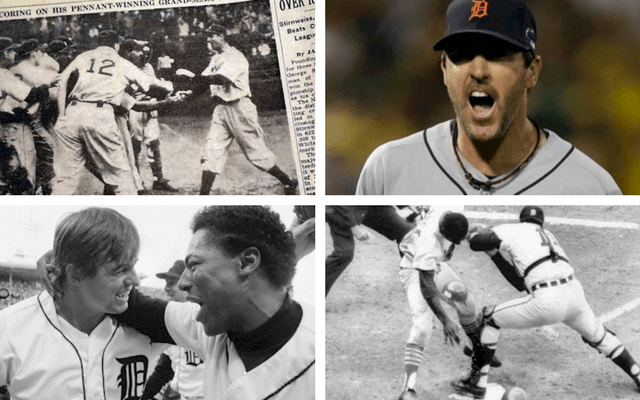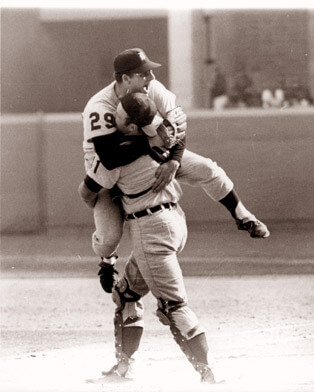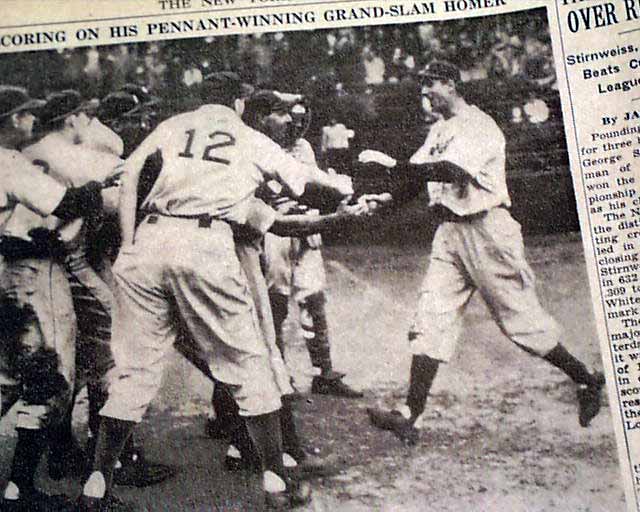
Hank Greenberg, Justin Verlander, Bill Freehan, and Frank Tanana played big roles in crucial victories for the Detroit Tigers in 1945, 2012-13, 1968, and 1987, respectively.
What is a crucial victory? Think important. These wins were critical in the history of the franchise, which dates back to 1901 in the American League.
A quick note: I don’t have any games from the 1935 World Championship season. I’ll probably get criticism for that. After all, that was the first title in franchise history. But I felt these nine were more crucial, because what was on the line. In ’35 the Tigers didn’t face much adversity as they won the pennant and World Series. Same for 1984. if you don’t agree, let me know in the comments section.
9. Gibby’s homer sinks Jays and sets up rally for division title in ’87
September 27, 1987, Detroit at Toronto
It the next-to-the-last Sunday of the regular season. Only eight games are left on the schedule and the Tigers are 3 1/2 games behind the Blue Jays. They’re in Toronto facing the Jays in the finale of a weekend series. The Blue Jays had won on Friday and Saturday in walkoff wins. It looked like Toronto might sweep the Tigers and essentially wrap up the division title. But Kirk Gibson had other ideas.
The Jays scored a run off Doyle Alexander in the first and Jim Clancy stymied the Tigers for seven innings, making the 1-0 lead hold up. Detroit batters were frustrated, and when Toronto closer Tom Henke came in he only made it tougher. Gibson faced him to lead off the ninth, Detroit still scoreless and trailing by one. On the third pitch of the at-bat, Gibby drilled a fastball from Henke deep over the wall in right-center to tie the game. The 46,000+ fans who had been ready to celebrate a sweep were suddenly silenced. But the drama was far from over.
Sparky Anderson left the game in Alexander’s hands, allowing the righthander to pitch into the ninth and extra innings. In the top of the 10th, Darrell Evans lofted a high flyball over the left field wall for a home run to give Detroit a 2-1 lead. But Alexander got into trouble in the bottom of the inning and a Jesse Barfield single that just eluded the glove of Alan Trammell tied the pivotal game again.
The game dragged into the 13th where Gibson again made his presence felt. Jim Walewander led off with a walk for the Tigers and was sacrificed to second by Lou Whitaker. Toronto manager Jimy Williams then made a head-scratching decision that might have cost the Jays a division title. He chose to intentionally walk Evans in order to face Gibson. Blue Jay reliever Jose Nunez tried to sneak a fastball past Gibby and failed. The pitch went back up the middle for a single, sending Walewander home with the tie-breaking run. Mike Henneman and Greg Thurmond combined to get the final three outs and the Tigers won 3-2 in 13 innings, inching back to within 2 1/2 games of Toronto.
Why was this game so crucial? It allowed the Tigers to stick close and set the stage for an epic comeback. from Monday-Thursday, Detroit split a four-game series against Baltimore, but Toronto lost three straight to the Brewers. As a result, when the Jays arrived in Detroit on the final Friday of the season for a three-gamer at Tiger Stadium, they were only one game ahead of the Tigers. Go to #3 on this list to see what happened.
8. Verlander handcuffs A’s to win Game Five in 2012
October 11, 2012, Detroit at Oakland
Talk about a hangover. The Tigers were within one strike of closing out the series the day before but watched as Jose Valverde blew the save in the ninth. That meant ace Justin Verlander had to take the hill for a win-or-go-home Game five in Oakland. He left no doubt who was the boss.
Verlander didn’t need any help from the bullpen, going all the way for a 6-0 victory to send the Tigers to the AL Championship Series. The righty struck out 11 batters and allowed only five baserunners in a dominant performance.
7. 10-run inning propels Tigers to rout in Game Six of ’68 Series against Cardinals on the road
October 9, 1968, Detroit at the St. Louis Cardinals
In his previous start in the ’68 World Series, Denny McLain had not survived three innings as he lost his second game of the postseason. But in Game Six the 31-game winner had something to prove. It helped that Detroit plated ten runs in an offensive explosion in the third, but McLain was stingy, allowing only seven singles and two doubles in a complete game victory that tied the series. This win is often overlooked, but it set the stage for Game Seven and history.
6. Verlander breaks hearts in Oakland again
October 10, 2013, Detroit at the Oakland A’s
68 years to the day after Hal Newhouser took the mound for a must-win game in the postseason for Detroit, ace Justin Verlander did the same. This time it was Game Five of the AL Divisional Series against the Athletics. Detroit had forced a Game Five by beating Oakland in Comerica Park two days earlier behind Max Scherzer. Now, Verlander was facing the A’s in the same situation as one year earlier. The result was the same.
Verlander struck out five of the first nine batters and did not allow a baserunner until the sixth when he surrendered a walk. With two outs in the seventh, Yoenis Cespedes broke up the no-hitter with a single. But JV struck out the next batter for his eighth of the game. Verlander pitched the eight inning and fanned two more hitters to finish with ten K’s. In all, he tossed 111 pitches, fanned ten, walked one, and allowed only two measly singles. No Oakland hitter advanced past first base. The Tigers won 3-0 to eliminate the A’s for a second straight season.
5. Early offensive outburst backs Newhouser in Game Seven of ’45 World Series
October 10, 1945, Detroit at the Chicago Cubs
Two days earlier the Tigers had lost Game Six on a walkoff hit in the 12th inning. Now they would have to win Game Seven in Chicago to capture their second championship. It would prove to be over very quickly.
The first three batters of the game singled for Detroit to score a run. A bunt, an intentional walk, and an out later, and a free pass forced in the second run. Then catcher Paul Richards delivered a big blow for the Bengals, crushing a pitch that landed just inside the left field foul line for a double. The hit cleared the bases and gave the Tigers a 5-0 first inning lead. They tacked on another in the second and never looked back, winning 9-3 as Hal Newhouser cruised to victory and was on the mound for the 27th and final out that gave Detroit the World Series title.
4. Behind Lolich, Detroit stays alive by winning Game Five of ’68 World Series
October 7, 1968, St. Louis Cardinals at Detroit
This was the pivotal game of the ’68 Series. Detroit was down 3-1 in the Series and looked dead. It was a Monday afternoon game at Tiger Stadium, and who knows how many school kids skipped that day to be in the old ballpark. Those that did saw history. The Cards built a 3-0 lead, but the Tigers clawed back and they stayed close on a controversial play in the fifth. Lou Brock was on second base when Julian Javier lined a single to left fielder Willie Horton. Brock sped around third to home, but inexplicably chose not to slide at the plate. He was met by the baseball and the immovable Bill Freehan. The Cardinal speedster was out, and a rally was thwarted. The Tigers scored the final three runs of the game and won 5-3 behind a complete game from Mickey Lolich.
3. Sparky’s veteran team defeats Blue Jays in Game #162 to win AL East crown in ’87
October 3, 1987, Toronto Blue Jays at Detroit
The 1968 season was emotional, with several late-inning rallies. The postseason followed suit. The ’84 season was dominant, the Tigers rolling over their competition. In a way, the 1987 campaign was more thrilling than those two, even though the Tigers fell short in the playoffs. The regular season started awfully, the team falling to 11-19 and last place in May. It was a talented veteran bunch. Almost like a switch, the Tigers flipped into gear in late May and played at a torrid pace, winning two of three here, and 7 of 10 there. But the rival Blue Jays were playing .600 ball and maintained a lead into mid-August. That’s when Sparky Anderson’s club caught Toronto. The two teams slugged it out the rest of the way. The back and forth was dramatic, but the finale topped it all.
Wouldn’t you know it? The two teams were scheduled for a three-game series on the final weekend of the season at Tiger Stadium. Entering the series, Detroit trailed Toronto by a single game. The Tigers won on Friday 4-3 behind Doyle Alexander, who improved to 9-1 since being acquired at the trade deadline. On Saturday afternoon the Tigs and Jays battled into extra innings. In the bottom of the twelfth, Alan Trammell grounded a single to left field between third and short to score the game-winning run in a 3-2 triumph that put Detroit in first place.
The Sunday game (#162 on the schedule) pitted veteran southpaw Frank Tanana against Toronto lefty Jimmy Key. The two pitchers were brilliant, but Key made one more mistake than Tanana — a hanging curve ball to Larry Herndon that the Tiger deposited into the left field stands. The lone run held up for a 1-0 Tiger win. With 98 victories, Detroit had the best record in baseball and captured the AL East title. The entire weekend was nerve-wracking and thrilling.
2. Tigers complete comeback against the Cardinals in ’68 World Series
October 10, 1968, Detroit at St. Louis Cardinals

Mickey Lolich started and won Game Seven on two days rest. He not only pitched, he pitched brilliantly. He pitched a complete game, his third in eight days. The Cardinal lineup was stymied by his left-handed offerings, going down 4-1, the one run coming harmlessly on a homer in the bottom of the ninth.
Had the Tigers lost the Series (as they were supposed to do), they would be still be remembered in Detroit. The roster was filled with several very good players and one or two great ones, like Al Kaline, Lolich, and the meteoric Denny McLain. They had a team character that was very appealing, led by colorful Norm Cash, and fiery competitors Jim Northrup, Dick McAuliffe, and Lolich. But they won the Series, and the way they won it, coming back from 3 games to 1 down, has cemented their status as one of the all-time great Detroit teams.
1. Greenberg’s grand slam clinches ’45 pennant on final day of the season
September 30, 1945, Detroit at St. Louis Browns

Potter was a pretty unspectacular pitcher who was enjoying his best seasons in World War II against poor competition. A great athlete as a youth in Illinois, Potter had been a superb basketball player, tennis player, and even earned laurels for his track and field exploits but chose baseball and pitching as his profession. He was a great at almost every competitive endeavor, known for being a clever card player, pool shark, and excellent at tossing horseshoes. His pitching repertoire was pretty average though, his fastball well below big league average speed. As a result, Potter resorted to special pitching tactics, some of them not exactly legal. The St. Louis righty was a known practitioner of the spitball.
Pinch-hitter Hub Walker started the ninth with a single. Manager Steve O’Neill sent Red Borom in to pinch-run for Walker, representing the tying run. Potter was tiring and walked Skeeter Webb to put runners at first and second. Little Eddie Mayo followed with a perfectly executed sacrifice bunt to push the runners ahead 90 feet. Trusty veteran Doc Cramer was next, 39 years old and in his 17th big league campaign. Potter and Doc had faced each other many times before, and the pitcher worked carefully against Detroit’s #3 hitter. Looming on deck was Hank Greenberg, the powerful slugger. But Potter tossed four pitches, a few of them “wet” and wide, and the bases were loaded. Borom was at third, Webb at second, and Doc at first with Hammerin’ Hank coming to the plate.
Less than 6,000 fans were in the stands at old Sportsman’s Park when Greenberg stepped in to face Potter. In the modern game, a relief ace would have been summoned from the bullpen long before the situation got that dire. But in 1945, you “danced with the one who got ya there.” It was Potter’s game and he had the unenviable task of facing one of the most fearsome men with a bat in his hands.
Greenberg, who missed almost five years to service in World War II, had only been back in the United States for a few weeks. He’d already made an impact, hitting a dozen homers and sparking the Tigers to a drive for the flag. With the bases loaded, his team trailing by a single run, and a tired pitcher on the hill, odds were in his favor. Rust or no rust, Hank was a great hitter.
Potter tried to sneak a curve ball past Greenberg but the tall Detroit slugger twisted his hips in the righthanded batters’ box and sent his bat through the strike zone. The bat met the ball and sent it soaring high into left field. Few fans were in the stands, but eyewitnesses on the field would always remember it.
“That ball was as high as any home run I ever saw Hank hit,” Red Borom said. From his vantage point at third base, Borom should have know.
But while the ball was launched high into the Missouri ski, it was not a sure thing.
“Hank rarely hit cheap ones,” said starting pitcher Virgil Trucks, “but that one hardly grazed over the fence.”
Lou Finney was the Browns’ left fielder and he had a great look at it. But he ran out of real estate and watched fruitlessly as the high fly ball dropped into the left field grandstands at Sportsman’s Park. If there were any Detroit fans in attendance, their cheers would have echoed in the large, nearly empty ballpark. Manager O’Neill remembered pitcher Prince Oana nearly tearing off his neck with a hug in the dugout. Oana had only been with the Tigers for three weeks and had already made his final big league appearance, but for that moment he was as proud as any Detroit ballplayer ever has been.
Greenberg’s grand slam did not end the game. The Browns still had a turn at bat. O’Neill summoned Al Benton, the tall Okie, from his bullpen to nail down the victory. Working with a three-run cushion, Benton allowed a scratch single in the ninth, but got Len Schulte, who was born only blocks away in St. Louis, to hit a weak grounder to end the game. Detroit had won a war-torn pennant thanks to the clutch hitting of their biggest hero, Hank Greenberg.



